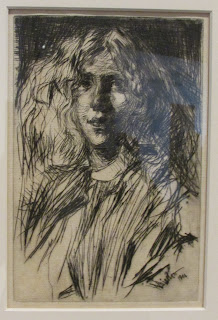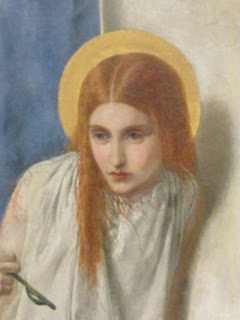James Abbott McNeill Whistler - Symphony in White, No. 1: The White Girl, 1862 (detail)
"Frederic
Leighton to James McNeill Whistler: 'My dear Whistler, you leave your
pictures in such a sketchy, unfinished state. Why don't you ever finish
them?' James McNeill Whistler to Frederic Leighton: 'My dear Leighton,
why do you ever begin yours?"
A small, but focused exhibition this detailing the relationship between talented artist and waspish, provocateur James Abbott McNeill Whistler, and his flame-haired muse, model and business partner Joanna Hiffernan. I am a great admirer of Whistler's work so it was a real pleasure to see all three of his Symphony in White paintings gathered together here in the same room as the central premise of this exhibition. Joanna (Jo) Hiffernan (1843-1903) was born in Limerick and emigrated from Ireland to London with her parents. Hiffernan met Whistler aged 17 whilst working as a model. The two embarked on a 6-year relationship which produced some of the finest paintings of her modelling career. The relationship was met with disapproval by Whistler's family as unmarried models in that period were regarded as little more than prostitutes. Nevertheless their relationship remained strong for as long as it lasted, with Hiffernan selling paintings on Whistler's behalf and also looking after his son from another relationship. Whistler left a will leaving everything in Hiffernan's favour when he died. During their travels in France Whistler formed a friendship with artist Gustave Courbet who also fell under the spell of Hiffernan capturing her beauty in several canvases too. The exhibition also contains seascapes by the two artists captured on joint holidays in Trouville together. Hiffernan doesn't appear to have been beautiful in the conventional sense of the word, but rather appears to have satisfied the vogue at the time for natural redheads, so beloved of, and made famous by the Pre-Raphaelites and other painters of the period. The original Symphony in White was rejected by both the Royal Academy and the Paris Salon, but was eventually accepted by the Salon des Refusés. Whistler was so good at instilling an atmosphere in his paintings, creating nuanced tonal harmonies and in the case of this trio of symphony in white paintings a broad palette of whites with hues ranging from warm creams to cooler greys that set a particular mood for the series evoking a complete sense of wistful, contemplative calm. These and other paintings in the exhibition demonstrate the fashion for Japanese prints and porcelain in the West at the time, and just how visionary and ahead of the the game Whistler was in terms of adopting a modernist approach to art. Having lived in Paris, Whistler was well aware of trends and developments across the Channel, and would include these developments in his own work. His painting Wapping, stands out here for being a more natural/realistic and modern depiction of life in comparison to some of the very mannered Victorian paintings on display here. Perhaps sparked by the celebrated Wilkie Collins novel, the theme of the woman in white really captured the artistic imagination of the period, and towards the end of the exhibition there are further striking painted portraits depicting the theme, the most notable of which is definitely Gustav Klimt's Portrait of Hermine Gallia, 1904. Other highlights from Whistler's oeuvre on display here and witnessed personally for the first time by myself in the flesh, so to speak are - Purple and Rose: The Lange Leizen of the Six Marks, 1864,Wapping, 1860-64, and The Artist in His Studio, 1865-72 and 1895.
Symphony in White, No. 1: The White Girl, 1862
Symphony in White, No. 1: The White Girl, 1862 (detail)
Symphony in White, No. 1: The White Girl, 1862 (detail)
Symphony in White, No. 2: The Little White Girl, 1864
Symphony in White, No. 2: The Little White Girl, 1864 (detail)
Symphony in White, No. 2: The Little White Girl, 1864 (detail)
Symphony in White, No. 2: The Little White Girl, 1864 (detail)
Symphony in White, No. 2: The Little White Girl, 1864 (detail)
Symphony in White, No. 3, 1865-67
Symphony in White, No. 3, 1865-67 (detail)
Symphony in White, No. 3, 1865-67 (detail)
A White Note, 1862
Purple and Rose: The Lange Leizen of the Six Marks, 1864 (detail)
Purple and Rose: The Lange Leizen of the Six Marks, 1864 (detail of the frame)
Utagawa Hiroshige woodblock prints c. 1853
Gustave Courbet - Jo, La Belle Irlandaise, c.1866 -1868
Gustave Courbet - Jo, La Belle Irlandaise, 1866 -1868
Dante Gabriel Rosetti - Ecce Ancilla Domini! - The Annunciation, 1849
Andrée Karpelès - Symphonie en blanc, 1908
Sir John Everett Millais - The Somnambulist, 1871
Whistler's Woman in White: Joanna Hiffernan
until 22nd May
Royal Academy of Arts
Burlington House
Piccadilly
London
W1






































No comments:
Post a Comment